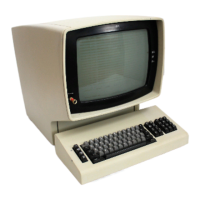Because the position
of
the cursor determines where the next character you key
is
entered, it
is
important to know how to move the cursor to any location on
the screen. Also, you will want to be able
to
move the cursor around quickly to
correct any errors you detect while working.
These keys are divided into two types:
1.
Those that move the cursor to the first character location
in
an input field.
2.
Those that move the cursor one or two character positions
at
a time.
Moving the Cursor
to
the Beginning
of
a Field
New Line
Key.
The
New
Line key moves the cursor
to
the first input character
location
of
the next line in which you can type. This new cursor location
de-
pends on the existing data displayed and on the screen format.
When the New Line key
is
pressed, there are
five
possible new cursor locations
where you may begin entering data:
1.
If
the screen
is
unformatted, the cursor
is
moved
to
the first position
in
the
next
line.
2.
If
the screen
is
formatted, the cursor moves
to
one
of
three locations
as
described
in
the following examples (the New Line key
is
pressed when the
cursor
is
located at A in Figure 3-20; then, the cursor moves to location
B):
a.
A character position within the
next
line,
as
shown in the top example in
Figure
3-20. In this case, the cursor
is
placed in the first input character
location past the protected field called
"ITEM DESCRIPTION:".
b.
The
first character position in the
next
line,
as
shown in the middle
example
of
Figure 3-20. In this case, no protected field or character
is
present at the first character position in the next line; therefore, the
cursor
is
positioned at the left margin in the next line.
c.
A character position on the first new line available.
It
may happen that
the first new line contains all protected fields. Therefore, the cursor
must keep searching until a new line
is
found that contains an input
field.
3.
If
all character positions on the screen
are
protected, the cursor
is
reposi-
tioned to the first location on line
1.
The New Line key
is
typamatic and moves the cursor quickly from line to line.
3-26

